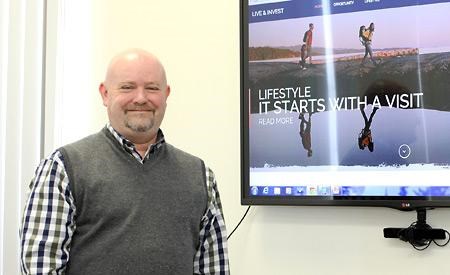Powell River’s regional population has been constant for years at about 20,000 residents. An initiative is being launched to add incrementally to that number.
Scott Randolph, City of Powell River’s manager of economic development, has unveiled a resident attraction campaign, developed in conjunction with Tourism Powell River, designed to bring new residents to the Upper Sunshine Coast. During a news conference on Friday, January 9, Randolph introduced a newly created website for this purpose. The site, operating under a logo “Powell River coastal by nature,” features compelling photography, statistics and video vignettes designed to highlight the economic, social, cultural and environmental amenities of the Powell River area.
“You really have to take a look at the population statistics over the last 10 years or more and we’ve been stagnant,” Randolph said. “We’ve seen a net increase of anywhere from half a per cent to one and a half per cent. We are inching toward the provincial average and we’d like to get up above the provincial average. I think a realistic, sustainable goal for this community, is in the three to four per cent population increase, year over year. It’s not a huge influx of people and it helps retain the charm and what makes it inviting and attractive to others. It will help bring new investment in.”
Randolph said the objective is to attract new residents, foster new investment and strengthen the economy.
“In terms of our goals, lowering the average age is a big one,” he said. “In the last census, we were very close to 51 years of age, average. Prior to that it was 48.”
One of the significant features of the newly launched website is a series of six video profiles featuring new residents, speaking compellingly about why they have moved to Powell River.
Randolph said the resident attraction initiative aims to diversify the population in Powell River and to strengthen the labour force.
“We need a young, skilled labour force to attract new investment to the community.”
Randolph said a lot of the foundation for the campaign is based on research conducted by Dr. Nicole Vaugeois, from Vancouver Island University.
“Dr. Vaugeois did a cross-Canada study, profiling and focus-grouping young professionals,” Randolph said. “She looked at how they choose where they settle. What she found is that it is lifestyle first. It’s all about those criteria that make them happy at a personal level, and then economic opportunities second, which is a reversal from the way it used to be. It used to be you migrated to wherever the job is. So we are seeing a change in how people make choices.”
Randolph said the resident attraction campaign is aimed at a demographic of people aged 25 to 55. He said the program, however, is focused on the younger end.
“We are interested in young professionals or young skilled people and young families,” Randolph said, “but we are not going to give up on early retirees. We think they bring and add something to the community.”
One of the key areas for attraction will be telecommuters—people who can do their jobs anywhere. Randolph said this will be helped by the fact that Powell River will have fibre optic connection for rapid online communications in the coming year. There is also a requirement in Powell River for skilled labour and entrepreneurs. The lesbian, gay, bi-sexual, transsexual community is also an identified sector in the campaign.
“We are a welcoming, inclusive community and we have a lot to offer,” Randolph said. “We’ve seen that community growing here.”
Randolph said messaging will be around lifestyle, affordability, cultural assets, recreation, safety, low crime rate, sustainability and Powell River’s temperate climate.
A social media campaign will be launched and a person is under contract to take care of posts using a variety of social media platforms, such as Facebook, YouTube, Twitter, Instagram and Google+.
On the print side, there will be a high-gloss, high quality, 16- to 20-page brochure. Design will begin next month. The brochure will be distributed in Vancouver, Calgary, Edmonton, Regina/Saskatoon, Toronto and Montreal.
“These are the key markets we want to hit with the focus being urban environments,” Randolph said. “Vancouver, for example, has become completely unaffordable. We are going to capitalize on this.”



